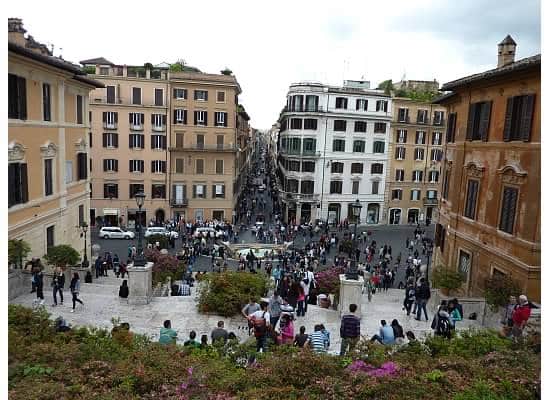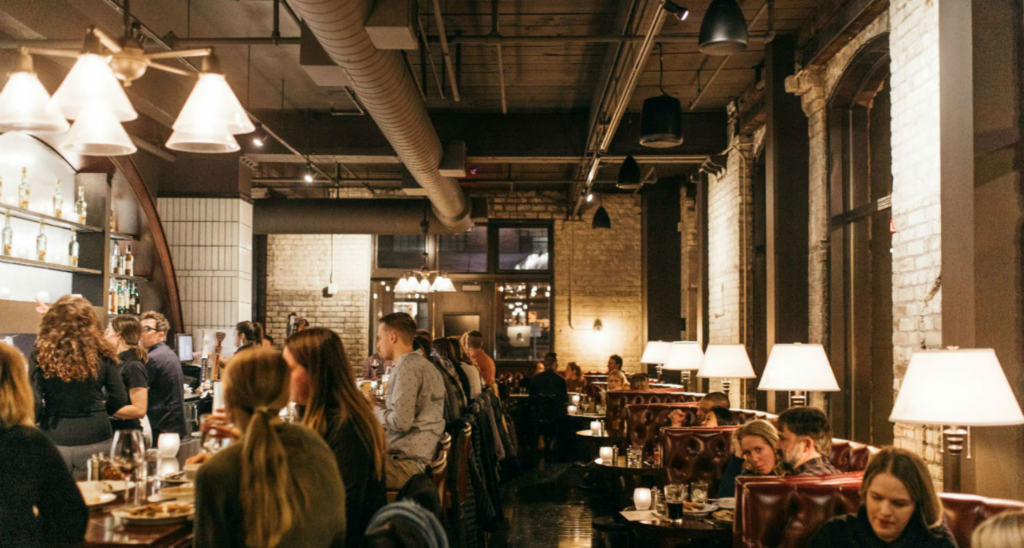July 23, 2016
Rome doesn’t suck.
I made peace with Rome at a small, off the beaten path restaurant. It was a combination of the sparkling wine (in a country of thick, dirty reds) and some fritto vegetariano. Deep. Fried. Vegetables.
On this tiny side street it finally felt smaller, less crowded, more accessible. Almost charming.
I didn’t come to Rome hating it. During the first few trips, the touristy side of the city left a not great impression of a big city with monuments and long lines in lieu of charm.
The real way to experience Rome is certainly not during culture week or any other major day off for the country when all entrance fees are waived. (When you book your trip, be mindful of Italian holidays. There are a lot of them.) Don’t approach the city as a forced march to see the sites. That’s the mistake I made in the first few trips.
The real way to experience Rome is a combination of seeing it from the hills (Aventine, Palatine with great views of the Colosseum and Circo Massimo), and wandering around the smaller neighborhoods. It’s also eating at the neighborhood trattorias understanding the following rules: #1: No plastic menus with pictures of food. #2: Make sure not all the patrons are Americans.
Experiencing Rome is drinking the house wine in a carafe (which, by the way, is more than a bottle as my liver and bladder reminded me). It’s making friends with the waiter to make sure he (they seem to be mostly men) doesn’t paint you with idiot American brush. Then, you’ll really get the good recommendations.
It’s sitting outside, in any weather over 50 degrees, bundling up and watching the neighborhood streets come alive and stay alive unlike anywhere in the U.S. (Even though every restaurateur in the U.S. has sought to duplicate the European dining experience.)
On the more touristy side, there is still a way to not be typical. St. Peter’s Square is certainly magnificent, but what about the original papal church near ancient Rome, San Laterano. Even better, catch a mass there in Latin. Even if you’re not Catholic, the ceremony will overwhelm you.
When you visit the Vatican, which you most certainly will do, book the night tour and see the beauty of the art and the space with incredible intimacy and lighting.
Or, just make sure you book a hotel with a rooftop, and spend time every afternoon having some wine or tea before dinner. Even if the view isn’t grand, enjoy looking at the other rooftops in the neighborhood and the laundry hanging out the windows. That’s when Rome charms.
The Trevi Fountain and Spanish Steps are walk-bys only, because they are always busy busy. Don’t plan a whole day around seeing them or hanging out there.
The Forum and Colosseum are a must, but not an entire day. (The walk up and around in the gardens is pretty spectacular). For Rome, it’s not the city as a whole, it’s the neighborhoods. It’s wandering on the side streets, happening upon the small gelato shop not found in any tourist guide. If you’re there multiple days, do the major tour spots in small doses, then spend some time in the neighborhoods: Aventino Hills, Trastevere (the old Jewish ghetto with tons of restaurants that has now gone from hip to touristy), Testaccio, an old stockyard neighborhood that now boasts one of the best (covered) food markets in the city, Gastronomia Volpetti.
A few recommendations:
Hotels:
There are literally a million hotels in Rome. Choose yours based on location first, then what appeals to you most as a second. For us, we like to be within walking distance of a number of places/neighborhoods, but not in ground zero (Trevi Fountain, Spanish Steps). If you do want to be on main and main, (some of our recommendations below qualify), make sure the hotel is a respite. Many are big and filled with business executives or families. Just know what you’re getting in to.
We love to stay in at least part of the time in the quieter area of Aventine Hill (one of the seven hills that makes up Rome). There isn’t much nightlife. You can easily go to Testaccio, Campo de Fiori or across the river to Trastevere for that. It does have pocket parks and one of the best views of Rome from the park right by S.Sabina (see the keyhole note below).
Just a few of our favorites:
One of our favorites from Florence has come to Rome. Can’t beat the location, and a great choice if you want a more contemporary boutique hotel experience.
A posh, Roman villa.
Newest in a string of chic city boutique hotels by Lungarno (also one of our Florence favorites). Right in the heart of tourist hell, but has a great rooftop and high prices, true to Lungarno style.
Located at ground zero and famous for its celebrity guests. It’s recently renovated and a great choice if you can get in.
One of our favorites in a quiet unassuming location on Aventino Hill. The location is close to great pocket parks with a view over the city, and the hotel itself has a great outdoor space. The secret to this location? There’s a keyhole at the end of the block that people were lining up to look through. After the second day, we were intrigued. We looked through and found the keyhole had the most perfectly framed picture of St. Peter’s.
Restaurants
Like Paris, Rome has great neighborhood joints, as long as you’re in a neighborhood. Just stay away from the places close to the tourist high points, and ask bartenders and waiters for recommendations, not just the concierge. Don’t kill yourself to find the right restaurants, find the smaller ones on side streets and use your instinct (and keep in mind the plastic menu with food pics advice).
A few restaurants that stood out for us:
Dot: in Trastevere
Da Felice in Testaccio: classic, spectacular pasta. One of our favorites
Pizzarium: legendary pizza by the slice joint that just expanded. North of the Vatican. (not worth the trip for it, but if you’re in the hood….)
Terre e Domus: the one exception to the above, it’s right in the heart of the archaeological center
La Gensola: great seafood in Trastavere
Flavio al Velavevodetto: great Roman classics in Testaccio
Armando al Pantheon: classic Roman restaurant that has been popular for decades, and a good choice if you’re near the Pantheon with all the tourist choices.
Foods not to miss:
Porchetta
Suppli (fried rice balls with tomato sauce. Best eaten from small takeaway shops)
Fritto. Yes, fried. (of course, I would probably eat my shoe if you deep fried it the way they do their veggies).
Pasta (duh)
Pollettidibollito (discs of simmered pulled beef breaded and fried. This is a snack. Best from the market in Testaccio)
Gelato (two favorites are Carapina and San Crispino)
Rome for us is great in small doses.
In Paris, you can wander around for a week. If you do that in Rome, you will grow a bit tired and the romance will wane. So, the best for us is combining with another place in Italy and get a true taste of Italia.
On the Side: How to Conquer Italy
Most people tackle Italy in one of two ways:
- See the entire country in two weeks or less including Venice, Milan, Pisa, Florence, Tuscany, Rome, Naples, Amalfi
- Park themselves in one of the above, usually Rome.
Are either wrong? That’s subjective. But after having been to all of the above (also including Cinque Terre, Puglia and Italian Lakes), our approach is different. Packing it all together is cheating. It’s like reading the Cliffs Notes versions of classic novels. On the flip side, just limiting yourself to Rome won’t give you the best sense of the beautiful Italian culture.
If you’re planning to go for the first time, or perhaps only time, the main question is what comes first?
We can’t answer that, but here are a few suggestions, somewhat in order:
Rome and Amalfi:
You can add Naples into it, but we haven’t peeled back the layers of the Naples cipollini to be able to recommend it. I think to love Naples you have to be in the mob, or know people in the mob.
So, along with Rome for XX nights, head to the Amalfi coast. They are close in proximity (you can drive or take the train and rent a car) and they give two totally different perspectives. If you do the Amalfi Coast the right way, it’s a collection of small towns and you can take a boat from one to the other.
Advice on the Amalfi Coast: Don’t stay in Positano. Stay with a view of Positano in Praiano. It’s an actual beautiful small town not overcome with tourists. From our balcony at Casa Angelina, we have a view of Positano at sunset. Near Amalfi, stay at Santa Caterina with a view, but also a bit of privacy. Or stay at Hotel Caruso in Ravello with the best views of the coast (but the downside is not being in one of the towns on the water).
Many would add Capri on to the Amalfi Coast. Great if you have time, but don’t rush it.
Florence and Tuscany:
This really shouldn’t need an explanation. Tuscany needs its own entry, and will soon. (alternate of Umbria if you’ve been to Tuscany).
Lucca and Cinque Terre (with probably Florence thrown in):
Lucca gives you a bit of the flavor of the wine regions, combined with an incredible historic walled city. It’s close to Pisa if you like, but it’s an easy jump to get to Cinque Terre. The Cinque Terre is as dramatic as the Amalfi Coast in a different way, and touristy for Italians and Europeans instead of the entire world.
They’re easy to get back and forth, and two very different experiences. For these cities, try either 2-3 days or a lifetime if you can swing it (as with most of Italy, a lifetime immersion would be ideal).
Milan and Italian Lakes:
Milan isn’t a city to overstay, so spending a day or two, then heading to the northern lakes is a great combo. Lake Maggiore is much less “found” than Lake Como.
If you’ve been to Italy before and seen some of the above, some alternates:
Rome and Sicily:
Sicily can really be experienced on its own, but you need to fly through Rome. Instead of powering through, spend a few days in Rome, then head to Sicily for a dramatic difference.
Rome and Puglia:
Puglia is the new frontier, and a completely different Italian experience.
And, if you want to stay city focused, the only choice is a combo of Rome and Florence. Four days Rome, three days Florence will get you there.
If all the above is been there done that, head to one of the cities, then go up north and hike the Dolomites. We may take our own advice next year…



